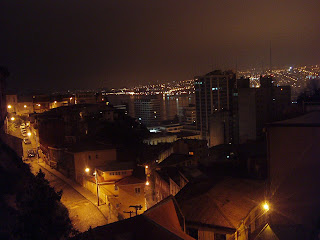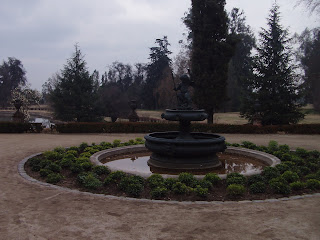
Friday, September 7, 2007
Leaving Chile

Casillero del Diablo
That was three (or was it four?) weekends ago. I set off for the village of Pirque, which the website said was five minutes' drive by bus or taxi from the Plaza de Puente Alto Metro station. Hah, surely five minutes' drive is easily covered on foot? And so in an exercise of foolhardiness, I walked to the village from the station.
After forty-five minutes of trekking, with 5kgs of groceries in tow no less (couldn't resist the tasty treats the supermarket there was offering), I arrived at Pirque. It didn't seem to be populated by many people, because all I saw were restaurants, a farm or two, and the Concha y Toro and Baron Philippe de Rothschilde wineries. Only one piece of property seemed to be for residence, but it wasn't even occupied yet.

These 'huts' that sit outside that residential estate are actually offices for agents to deal with clients.
Colorful signs telling visitors where restaurants and attractions are located.
The village is filled with dogs. These appear to be watchdogs for the vineyard in the background.
Having some time to spare before the tour began, I took a seat on a park bench. Before long, I was approached by two dogs. For awhile, I thought they were expecting me to feed them, when the incredible happened. They started copulating right in front of me. That stopped after about a minute, but only because they moved to another spot, turned around and started again, as if to show me another angle. Several angles later, I decided it was time to go see more interesting things.

If you look carefully, the one on the receiving end is male.
I entered the winery, a sprawling estate of gardens and vineyards. As I joined others who had come for the same purpose, our guide, who spoke impeccable English, introduced himself. We were led to an old summer house with Victorian-style architecture.
Our guide standing in front of the plant-shaded pathway to the mansion.
This was built by the founder of Concha y Toro, Don Melchor. He resided in it with his wife, a rich heiress. After the company passed into new hands, the house was converted into a place to entertain clients and business partners, and for good reason. Aside from the beautiful architecture, the inside was tastefully furnished in the style of the French. The house overlooked an English garden, complete with the traditional rose bushes, water fountain and pond. Like other well-known vineyards in Chile trees from around the world had also been planted in the garden.
View from the front of the house.
Leaving the house, we proceeded to the vineyard. Here, the guide explained that the reason for Chile's success at producing good, low-cost wines, was its unique location. Surrounded by the mountains, Chile was protected from diseases and insects that destroyed the grape. This meant growers had no need to invest in pest protection systems or chemicals. In addition, the consistently harsh climate allows growers to push the vines to their limits, causing them to fill their fruits with less water and hence higher concentrations of sugar.

We then had a tasting of a carmenere produced in that vineyard. This one was a huge contrast to the one I had at Undurraga. There were slight hints of wood and smoke, but the wine was on the most part a fruity one, with a bit of chocolate in the aftertaste.
Our next stop was the cellars. Here, wine was stored for ageing in traditional French oak barrels. We were told that only the good wines were given this treatment. Cheap, mediocre ones were aged in metal tanks, as is the practice in other Chilean wineries. But at Concha y Toro, only the best were kept in the famed Casillero del Diablo.


The history behind this well-known legend is more of a comedy, rather than what its name suggests. Don Melchor, upon finding that the wines in his cellar have been vanishing mysteriously, suspected local villagers of pilfering from him. He knew that being the superstitious simpletons they were, they'd fall for rumors of the devil hiding in that cellar, which he did spread. The ploy worked. Incredibly stupid, they seem to me.

In any case, the don was able to keep his wine, and had a corner of the cellar segregated as a private entertainment area for his friends. Above the entrance to this private enclave were words carved out of iron that said in Spanish, 'No devils in here'.


We concluded the tour with a tasting of what was touted to be the best wine produced by Concha y Toro, the Don Melchor, vintage of 2005. It was incredibly complex, unlike any other cabernet sauvignon I've ever tasted. Although I can't remember most of it, I believe there were plums and berries, with spices and some chocolate. But these did not occur at the same time. They came to you at different stages, with the spice hitting you at the nose and initial taste, which developed into fruitiness, and finally ending in a chocolate aftertaste.
Truly a worthwhile visit. I decided to take a bus back to the city.
Sunday, August 26, 2007
At the top of Santiago

The dust trail gets narrow at certain points along the way. Not a good idea to take this path on a rainy day.

Cherry blossoms grow wild on this hill. They begin shedding at this time, creating a pretty sight everytime the wind blows.
Left: View of the mountainside. It's hard to see, but somewhere below those pylons, a string of cable cars ferry passengers from one peak of the hill to the other.
It took about twenty minutes to reach the summit, including the time I was lost for after taking a wrong turn. The main attraction here is a huge statue of the Virgin Mary, visible even from ground level in the city.

In front of the statue is an open-air congregation area. I presume they hold Mass here sometimes.

Another view of the congregation area. That shelter-like structure down there houses an altar table.

Along the way up, as well as on the summit, I was able to find a few panoramic spots.



Being dissatisfied with the overly-touristy feel of the place, I snooped around and found an old path in overgrown with vegetation. Following it brought me to a great vantage point.


And that concluded my hike up the hill. It was almost sundown by the time I returned to the foot of the hill, and I didn't miss a great opportunity to grab this picture before I left for home:
Wednesday, August 8, 2007
Sunday, July 29, 2007
Weekend at Valparaiso
The reviews made mention of these. They are a source of incredibly cheap goods here in Valparaiso. Walking around them, however, made me decide that the only things that had value for money were fruits and seafood, which were really fresh. In one instance, I almost settled on a pair of sturdy leather gloves until a closer inspection revealed splitting seams filled with dried mud.


After browsing the stalls, I decided to walk through the shopping district, since it was on the way to my hostel. There wasn't really that much to see. Santiago had a much more vibrant commercial scene. I quickly located my hostel on the side of Cerro Bella Vista and checked in.



Most of Valparaiso is built on hilly terrain, spread over the numerous hills, or cerros, that surround the bay area. My hostel was no exception, but it wasn't too high up, fortunately. The ascensors, 'elevators' that transport people up particularly steep slopes, is an adaptation to such a terrain and a unique feature of Valparaiso. Unlike what many reviews claim, I thought the experience of riding up one was overrated. The convenience provided is worth the 200-peso fee though.

Another road going through the hill. Murals line many of the walls in what has designated 'the Museum of Open Skies'.
After checking-in, I proceeded up Cerro Bella Vista to visit Museo La Sebastiana, formerly a house belonging to Nobel laureate poet Pablo Neruda. Neruda loved strange and unusual objects. Not only did he fill his house with his weird collections, but he also made sure that the architecture was unique.
I walked through the entrance garden to find a block-like structure painted in a striking orange overlooking the bay. The stairways leading up through the five storeys of the house were narrow and could fit only one person. Moving up and down was quite a bother especially when people were coming from the opposite direction. Paintings of all styles hung everywhere on the walls. In all the rooms, there were exhibits of Neruda's collections. One showed his fascination with oriental art, while another had dinnerware sets with amusing caricatures of Western art figures on them. There was his bar where stuffed animals and antique bronzeware accompanied bottles of liquor and a sign which prohibited serious intellectual talk. Yet another room had a huge egg-shaped structure that served as a fireplace in the middle of the room. And every now and then, a porthole on the wall, like those on a ship, opens out to the sea. Surely my readers would forgive my lack of photographs, though. They stationed personnel on every storey to enforce the 'no fotografias' rule.
 The only picture I managed to sneak without their notice. Here we have plates with pictures of people fused with the bodies of various sea creatures. The nautilus one was most amusing.
The only picture I managed to sneak without their notice. Here we have plates with pictures of people fused with the bodies of various sea creatures. The nautilus one was most amusing.The rest of the day was spent exploring the city, going up Cerro Concepcion and Cerro Alegre, sampling seafood at Mercado Puerto. But frankly, I expected a lot more of this tourist lure that I had heard so much about, scenery-, experience-, and cuisine-wise. Perhaps the much-vaunted nightlife would be more up to expectations. I retired to the hostel to rest until night time.

 Navy headquarters at Plaza Sotomayor
Navy headquarters at Plaza Sotomayor
Right: A cemetary on top of a hill in the middle of the city. Charming.

I woke up at 11pm and promptly put on a coat before going out. My first stop was Cinzano, a restaurant pub well-known for its old, traditional singers. Raucous cheering greeted me as I stepped in. The place was chock-full of customers, clapping to the singing of this old man seated next to a band. There were no available seats, so I decided to stand and wait. Meanwhile, the old singer started on what sounded like a sea shanty. Well yes, it made the crowd jolly and had a beat to it, and the old-timer was going strong for his age, but this certainly wasn't my cup of tea. After waiting too long for a more promising number, I decided to find my fun elsewhere.
I stopped by several other more conventional bars, but these were either too full or completely empty. The music wasn't that great either. Where's a nice, cozy jazz bar when you need one? And I wasn't in the wrong place either. That street was touted to be Valparaiso's night life district. Finally, I settled for a simple fish supper at an empty restaurant on Cerro Alegre. After which, I wandered around the hills with my trusty camera, taking night shots of the city.




The following day, I checked out of the hostel and took a nice long stroll through the hills. My route took me through better scenery this time.






















